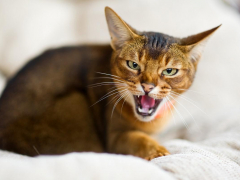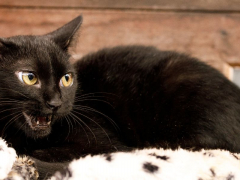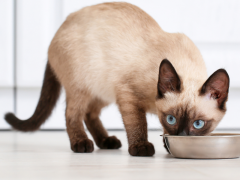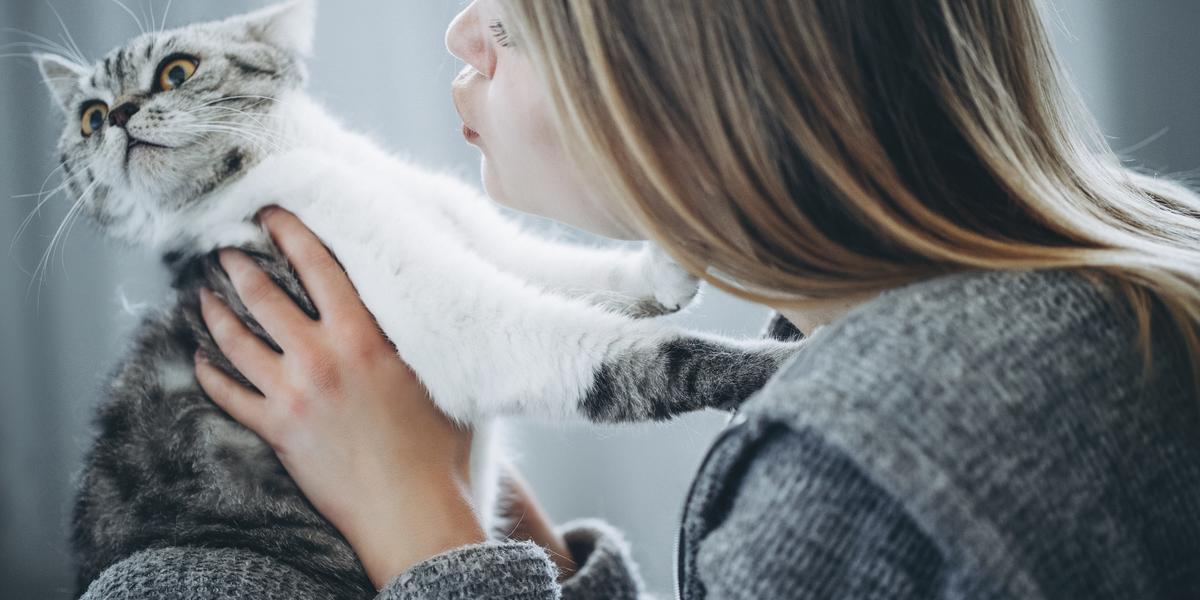
As we know, all cats are different and have their own personalities. They show affection in their own way, with some cats being very obviously affectionate and others less so. Some cats are friendly and enjoy having a close relationship with their owners. Other cats may be indifferent to human interaction or even avoid humans altogether.
Your cat’s personality is based on many factors and this can contribute to how affectionate they are or how they show it. Cats display affection in many different ways and we’ll discuss these signs below.
Subtle Signs of Feline Affection
We know the obvious signs of feline affection, for example, a cat that approaches us and is trying to be petted with lots of purring, or a typical lap cat that loves being near their owner. Some cat breeds like that Siamese are very vocal when showing affection. But you can learn to recognize some more subtle signs of feline affection.
Body language and vocalizations can help cat owners recognize more subtle signs that a cat is showing us affection. It’s helpful to understand these signs as you may think that your cat doesn’t like you or isn’t showing affection, but it may actually be displaying a subtle sign of affection.
Affectionate signs from your cat include:
- Approaching you or relaxing close to you (napping)
- Head butting/bobbing into you
- Purring
- Kneading paws (making bread)
- Rolling on back in front of you (don’t rub their tummy!)
- Slow blinking (relaxed)
- Approaching you with their tail raised and hooked/question mark position
- Rubbing their cheek against you
Subtle positive body language signs include:
- Ears slightly forward and raised
- Relaxed whiskers
- Relaxed facial expression (this is a bit harder to notice initially)
- Normal pupils that are not too dilated or constricted (the pupils may get a bit dilated during playtime or excitement)
- Relaxed body posture (e.g., stretched out, rolling, lying out)
Positive cat vocalizations include:
- A purr or constant purring
- Chirruping
- Soft, short meows when trying to get your attention
The above signs are all positive signals that a cat likes you or even loves you!
Affectionate cats act relaxed in your presence and sometimes even initiate affection. Remember, that not all cats want to sit on your lap or have cuddles, but this doesn’t mean that they don’t enjoy being around you.
If your cats is showing any signs from above, it means that they are comfortable and happy around you and you can be assured that your cat loves you.
We’ve covered obvious and subtle signs of affection but what if your cat isn’t displaying any of these signs?
Some signs that a cat doesn’t want affection or human interaction include:
- Raised hair on back or tail (called piloerection)
- Cowering away/keeping body close to the ground
- Ears flat against the back of their head or side of head
- Very dilated or constricted pupils
- Hissing, yowling or very loud meowing
- Tail swishing from side to side
- Staring, no blinking
- Not wanting to be close to you, trying to get farther away from you
If a cat is showing some of the signs above, it’s important not to approach them. The cat is likely to be anxious and fearful, and may become aggressive if approached. It’s important to respect the signals that a cat is giving you. The above signs indicate that they don’t want to be approached.
Why Are Some Cats Less Affectionate Than Others?
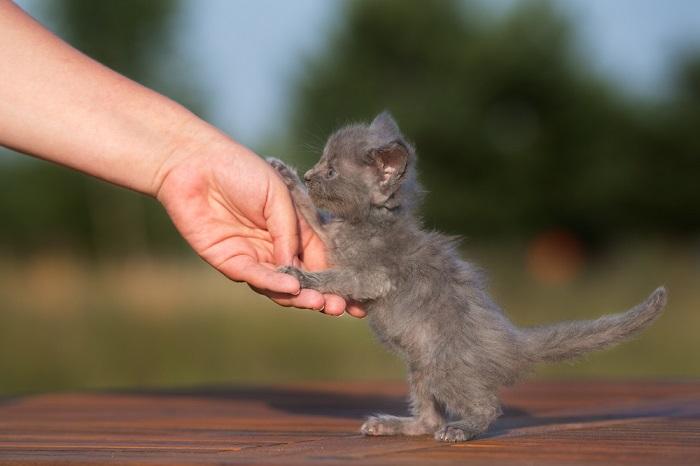
Kittens that don’t get socialization at the right age may grow up to be disinterested in humans or even fearful.
As we mentioned above, all cats are different and have different personalities. This is based on many factors, some of which we have no control over. One of the factors is the cat’s genetics.
If the cat’s parents were fearful of humans and had little interaction with them, this can pass onto the kittens of those parents. For this reason, breeders will often breed from friendly parent cats.
Another important factor is the cat’s socialization period as a kitten. The socialization period is between 2 to 7 weeks old when the kitten’s brain is still developing and they’re learning what is threatening and non-threatening.
It’s a crucial time for kittens to become familiarized with humans, other pets, everyday items in the house, etc. It’s important that human interaction is very positive during this period as negative experiences with humans can have long-lasting effects.
If a kitten didn’t get adequate positive contact with humans during this period, it’s possible that they may be fearful around people in the future. A kitten that is socialized after this critical period, may slowly accept human contact, but it’s they might have some anxiety or stress associated with human contact. We have to keep this in mind when we think of cats that aren’t very affectionate. The above factors may have had a major effect on this.
For example, a cat born to feral parents and with little human interaction during its socialization period, will likely avoid most human interaction. They may enjoy some interaction on their own terms and display some signs of affection, but overall, are likely to avoid close human contact.
It’s important to consider if the lack of affection is a new problem or if the cat has always been like this. Particularly if it’s a new problem, it’s important to consider stress and pain as potential causes of your cat being less affectionate.
Similarly to people, if we’re stressed or in pain we’re less likely to be in a friendly mood. Stress caused by a new cat in the house, a new baby, construction worker in the house, etc., can have a huge effect on how affectionate a cat might be.
Similarly, a cat in pain, such as one with osteoarthritis, cystitis, or another underlying disease, is very likely to show less affection. A veterinary examination should be performed to rule out underlying causes if your cat is showing less affection than usual or if you’ve noticed a change in their behavior.
How to Pet a Cat Correctly
Some ways of approaching and petting a cat may make the cat more likely to interact with you. It might be that you’re approaching cats in a threatening or invasive way that they don’t like, so read the tips below and it might help the next time that you approach a cat.
- Make your body language as least threatening as possible (e.g., sit on the floor or crouch down). This makes you seem smaller and less threatening to the cat.
- Don’t stare directly at the cat. Slow blink and avert your gaze.
- Stretch your hand out to the cat, either holding your hold in a loose fist or open with palm facing upwards. Allow the cat inspect or sniff your hand before attempting to pet it.
- Make chirrup sounds if you can, don’t make “psssh psssh” sounds as this can sound like a hiss to some cats.
- If you know the cat’s name, say it gently.
- Don’t force interaction. The cat may sniff your hand and then walk away, and that’s OK.
- Always allow the cat to come to you. Don’t invade the cat’s space.
Ways to Bond With Your Cat
To encourage a positive bond with your cat, it’s important to respect your cat and know what they enjoy. Think like a cat! Be calm, quiet, and patient, and allow your cat to approach you.
Encourage consistent, positive, and predictable human interaction. This may come in many forms depending on what makes your cat comfortable. It may be a few short pets during the day or a cuddle on your lap in the evening. It might be sitting next to you while you read a book or greeting you in the morning.
It’s important to be consistent and keep a routine with your cat (they enjoy routine) without making sudden changes. Be patient and positive no matter what—you may want lots of cuddles, but your cats may be happy with a short pet, so respect what makes your cat comfortable.
Encourage predatory behavior from your cat. Cats are natural hunters and they enjoy displaying predatory hunting behavior. This doesn’t mean allowing them to bite your fingers or hunt down your toes, though. Encourage playtime with lots of different toys. This can increase the bond that you have with your cat by taking part in something they enjoy.
Make sure that your cat has everything it needs to be happy and healthy. Ensure that your cat has enough litter boxes, food and water stations, safe areas to rest, scratching posts, toys, and areas to escape/hide. From a health perspective, make sure your cat is free from pain, discomfort, and stress, and is on a good quality diet.
This is important because you can’t expect your cat to be comfortable and happy bonding with you if they’re stressed or suffering from an illness is in pain.
How to Bond With a New Cat
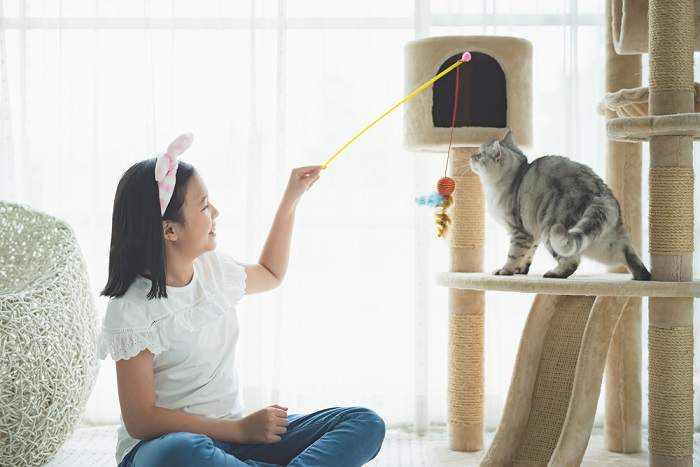
Play with your cat to increase your bond by taking part in something they enjoy.
Moving into a new home can be quite overwhelming for a new cat or new kitten, so it’s important to let them settle into their home and become familiar with everything.
Make sure that they have their own bed (including hiding areas), litter boxes, food and water bowls, and scratching posts. Ensure that you do introductions with other pets slowly and research this beforehand.
Be patient with them while they’re settling in and let them relax in their new environment. Once they seem more relaxed, start scheduling in some playtime and see what sort of toys they prefer.
Some cats enjoy toys that have catnip added to them, while others may not. Encourage petting and affection if your cat seems interested in interacting with you. To help them become more relaxed, offer tasty treats to encourage them to approach you.
However, never withhold food based to do this (for instance, keeping the cat’s food bowl next to you so that they have no option but to interact with you in order to eat). It’s important for the cat to have a choice.
Summary
I hope you can now understand why some cats show more affection than others. There’s more than one way that a cat can show affection and it’s important to remember that cats show affection differently than humans do.
Now that you can recognize the signs, you might realize that your cat actually does show you affection, but in their own unique way. Understanding your cat will lead to a happy relationship for both of you.
Frequently Asked Questions
Why is my cat not very affectionate?
All cats are different and their personalities are dependent on factors such as genetics and the human contact that they had during the early kitten socialization period. It may also be that your cat is showing you subtle signs of affection that you may not notice. If it’s a sudden change in your cat’s behavior, seek veterinary advice.
How do I get my cat to be more cuddly?
We can’t force our cats to be cuddly, but we can encourage a better bond by consistent positive human interaction, encouraging playtime, and ensuring our cats are healthy and not stressed in their environment (providing enough resources).
Why does my cat not cuddle with me?
It might be that your cat doesn’t display affection by cuddling and that they show affection in more subtle ways. It’s important to remember that cats show their affection for us in many different ways.
Will my cat ever become affectionate?
It depends on how well socialized a cat was with humans during their socialization period and their genetics. With positive human interaction and understanding cat behavior, some cats may show more affection in time. It’s important to know the subtle signs of cat affection and recognize that cats show affection differently to humans.

